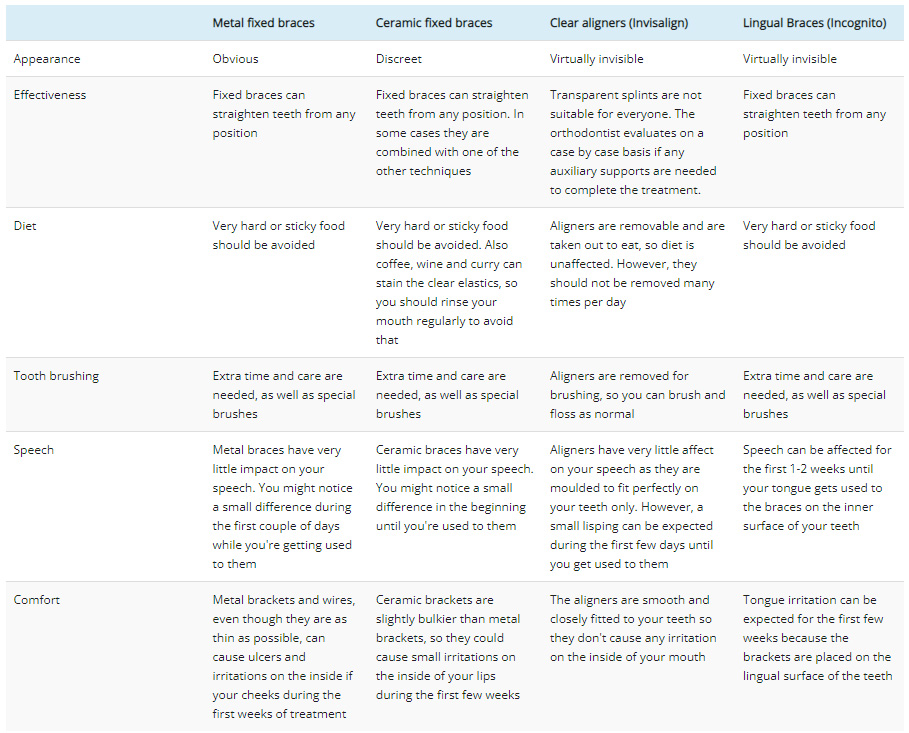With modern developments, there are tools that show you what your smile might look like at the end of treatment. This is a simulation tool, which does not correspond 100% to the realistic result, which depends on many factors. You can find such a tool here:
Of course! Orthodontics is based on the process of absorbing and creating bone around teeth through applying gentle force by our mechanisms - this process remains active throughout life. Some serious health problems may be a contraindication but the orthodontist will guide you properly after taking a detailed history.
It’s good that the orthodontist examines a child at around 7 years old. Usually no intervention is needed then, except in cases of skeletal and / or functional dysfunctions that may cause more serious problems in the future (eg posterior maxillary position, cruciate ligament displacement with mandibular displacement at closure).
The orthodontist then pulls out one individualized recall schedule , to make sure that the child gets the best (and shortest) treatment possible, which can be done if treated at the right time. Keep in mind that the same problem can have different impact and needs different timing and treatment on different people, so an individual check up schedule is the easiest way to avoid long-and costy- treatment in the future.
Oral hygiene is a cornerstone of a proper treatment. The orthodontist shows you exactly how to clean your teeth and braces by giving help when needed and recommends a visit and cleaning to your dentist every few months depending on the occasion.
Care must also be taken with the food so that the braces or wires do not break, as this causes the teeth to return to their original positions and the treatment time is extended. Cola-type soft drinks should also be avoided, as well as the consumption of snacks and sweets between meals, as the mechanisms make it difficult to clean teeth and intensify the retention of dental plaque (germs and food debris). Detailed instructions are given to you orally and in writing when the mechanisms are installed.
Scheduled appointments must be kept. Orthodontic treatment proceeds according to plan with pre-arranged appointments every 4-6 weeks usually. The frequency of appointments depends on the type of mechanisms used, as well as the stage of treatment. When appointments are not kept, time is automatically lost in the smooth course of treatment and this can have consequences both in the total time it will take and in the quality of the result.
Many times elastics are needed, disposable rubber bands that must be worn either 24 hours / day, or only at night. These are necessary in order to achieve the goals of the treatment, so that it can be completed on time.
The most common question is of course whether orthodontic treatment hurts. The placement of the mechanisms is completely painless. After a few hours, a mild initial discomfort begins, which gradually becomes more intense over the next 2 days. It is usually pain while chewing (when the teeth are pressed together) or automatically as a feeling of "tight pull". Mild analgesics (paracetamol) help in the first days, as well as the consumption of soft foods in small bites.
TIP! The first wires placed in the braces are usually super-elastic heat-activated, so they are active at mouth temperature. This means that the cold water slightly relieves the pressure exerted.
In our office we use brackets that can safely remain in the mouth during an MRI scan. Their certificates are given to the radiologist if necessary. The same applies to the retaining wires that are inserted after the end of the active treatment. Depending on the area of the body that needs to be examined, the orthodontist in collaboration with the treating physician and radiologist decide on a case-by-case basis. You should always inform your orthodontist about a scheduled MRI scan.
Although allergies to orthodontic materilas are rare, there are alternatives. Titanium brackets and nickel-free wires are used when necessary, as well as e ceramic materials and transparent aligners. Also, gloves without powder and latex are used routinely in our office to avoid allergic reactions to these materials. Your orthodontist should be aware of any hypersensitivity you may have (eg a skin reaction to gold-plated jewelry may indicate some nickel sensitivity), at whatever stage of treatment you are at.
Some women experience hyperplasia (swelling) of the gums during pregnancy. This is due to hormonal changes and plaque retention (ineffective brushing). Fixed orthodontic appliances make oral hygiene difficult, so extra care is needed to keep teeth and gums healthy. Pregnancy is not a contraindication to orthodontic treatment, but each case must be dealt with individually to decide on the most complete personalized treatment plan.
Retention is an integral part of orthodontic treatment. The mouth is a part of the body that is constantly changing based on the balance of forces exerted. The duration of this phase of treatment depends on many factors, such as the initial condition and the treatment plan. It usually involves a fixed wire on the back of the front teeth and a transparent splint used during sleep. The personalized suitable mechanism may differ both in form and in the time it must remain in the mouth.
The cost includes the records and diagnosis of the malocclusion (first two appointments), the mechanisms and visits during active treatment (as the case may be, usually every 4-6 weeks), emergency visits, the mechanisms for maintaining the result that are placed after the end of active treatment and monitoring them after placement. The payment plan is decided during the discussion of the treatment plan and it is possible to create interest-free installments, with a personalized plan for you that will suit your needs.


